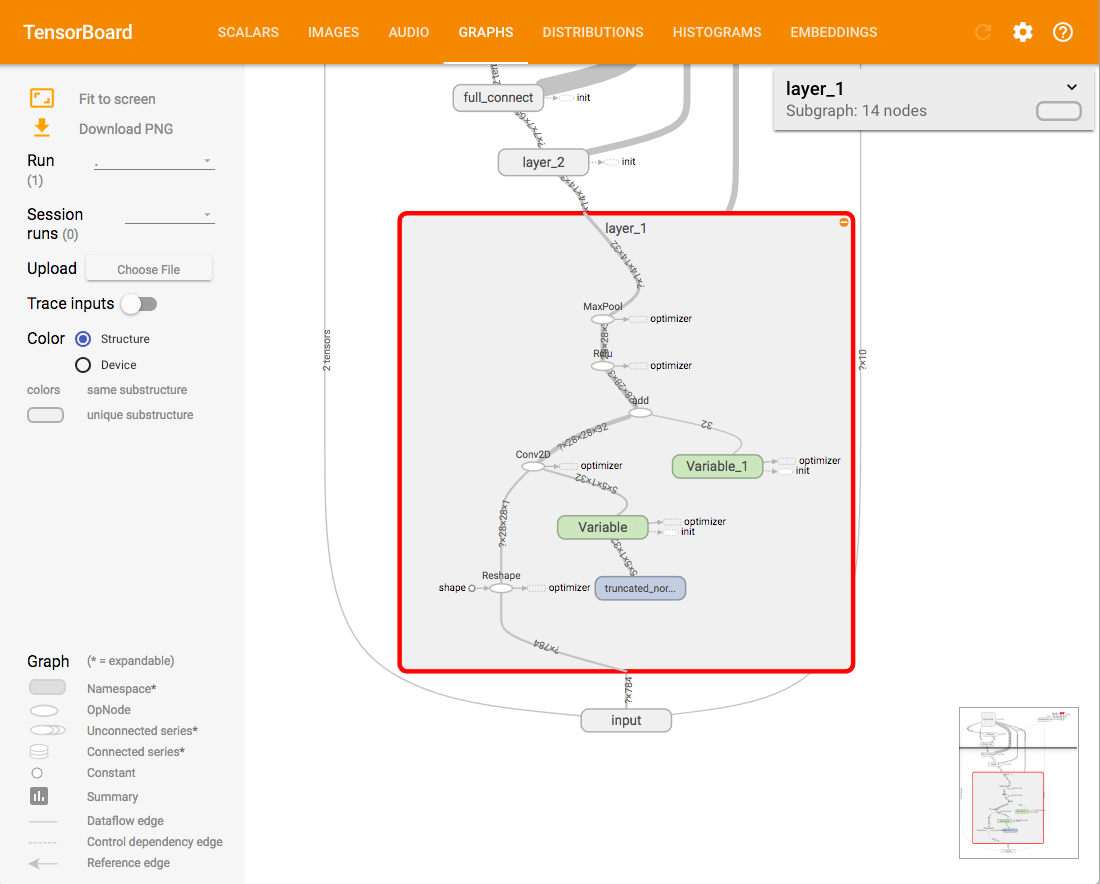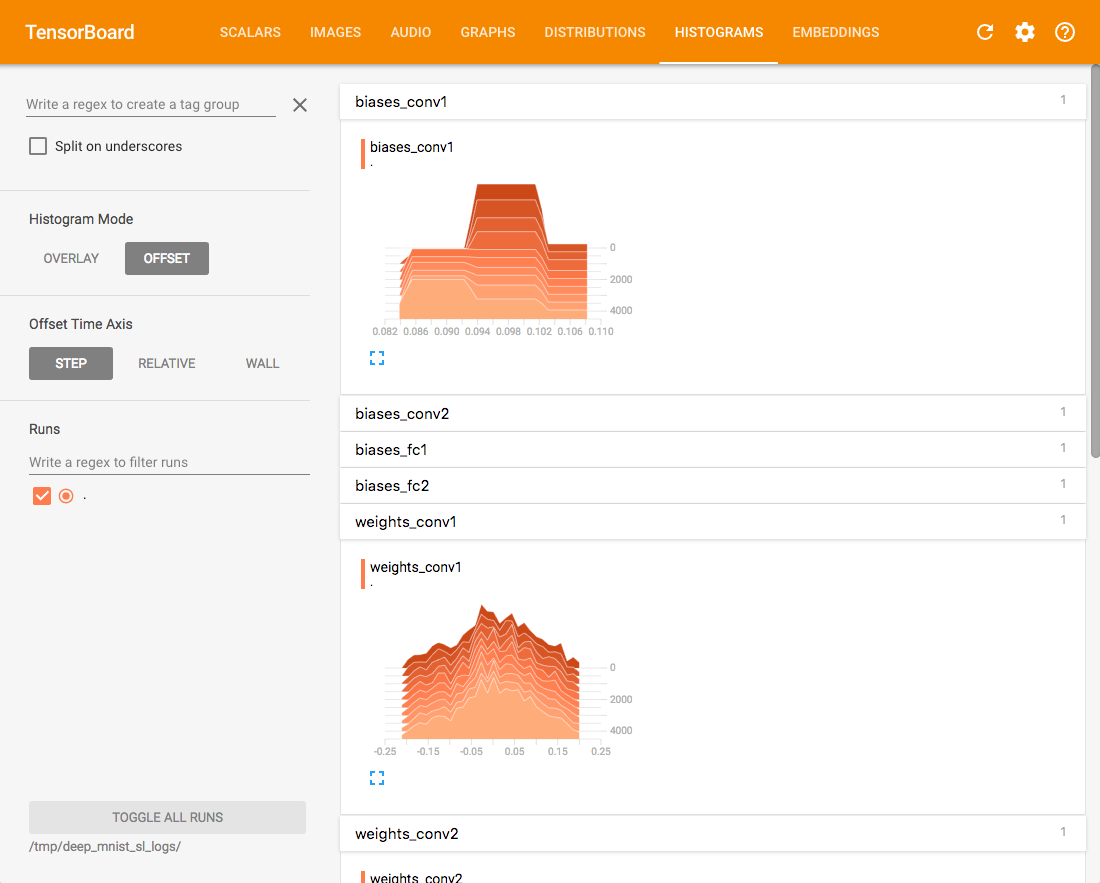前回作成した畳み込みニューラルネットワークを TensorBoard を使って視覚化します。
TensorBoard
TensorBoard は、プログラムの理解、デバッグ、および最適化を容易にするための視覚化ツールになります。
https://www.tensorflow.org/get_started/summaries_and_tensorboard
https://www.tensorflow.org/get_started/graph_viz
準備
前回のエントリーで作成したソースコードを用意します。
このコードに TensorBoard 用のコードを追記してきます。
実装コード全体
実装コードの全体は、下記となります。
deep_mnist_softmax.py
from __future__ import absolute_import
from __future__ import division
from __future__ import print_function
import argparse
import sys
from tensorflow.examples.tutorials.mnist import input_data
import tensorflow as tf
# 重み変数
def weight_variable(shape):
initial = tf.truncated_normal(shape, stddev=0.1)
return tf.Variable(initial)
# バイアス変数
def bias_variable(shape):
initial = tf.constant(0.1, shape=shape)
return tf.Variable(initial)
# 畳み込み
def conv2d(x, W):
return tf.nn.conv2d(x, W, strides=[1, 1, 1, 1], padding='SAME')
# プーリング
def max_pool_2x2(x):
return tf.nn.max_pool(x, ksize=[1, 2, 2, 1],
strides=[1, 2, 2, 1], padding='SAME')
def main(_):
# データ取得
mnist = input_data.read_data_sets('MNIST_data', one_hot=True)
# placeholder作成
with tf.name_scope('input'):
x = tf.placeholder(tf.float32, [None, 784], name="x")
y_ = tf.placeholder(tf.float32, [None, 10], name="y_")
# 畳み込み1層目
with tf.name_scope('layer_1'):
W_conv1 = weight_variable([5, 5, 1, 32])
b_conv1 = bias_variable([32])
x_image = tf.reshape(x, [-1,28,28,1])
h_conv1 = tf.nn.relu(conv2d(x_image, W_conv1) + b_conv1)
h_pool1 = max_pool_2x2(h_conv1)
# 畳み込み2層目
with tf.name_scope('layer_2'):
W_conv2 = weight_variable([5, 5, 32, 64])
b_conv2 = bias_variable([64])
h_conv2 = tf.nn.relu(conv2d(h_pool1, W_conv2) + b_conv2)
h_pool2 = max_pool_2x2(h_conv2)
# 全結合層
with tf.name_scope('full_connect'):
W_fc1 = weight_variable([7 * 7 * 64, 1024])
b_fc1 = bias_variable([1024])
h_pool2_flat = tf.reshape(h_pool2, [-1, 7 * 7 * 64])
h_fc1 = tf.nn.relu(tf.matmul(h_pool2_flat, W_fc1) + b_fc1)
# ドロップアウト層
with tf.name_scope('drop_out'):
keep_prob = tf.placeholder(tf.float32, name="keep_prob")
h_fc1_drop = tf.nn.dropout(h_fc1, keep_prob)
# 出力層
with tf.name_scope('output'):
W_fc2 = weight_variable([1024, 10])
b_fc2 = bias_variable([10])
y_conv = tf.matmul(h_fc1_drop, W_fc2) + b_fc2
# optimizer
with tf.name_scope('optimizer'):
# 損失関数(交差エントロピー誤差)
cross_entropy = tf.reduce_mean(tf.nn.softmax_cross_entropy_with_logits(y_conv, y_))
# 勾配
train_step = tf.train.AdamOptimizer(1e-4).minimize(cross_entropy)
# evaluator
with tf.name_scope('evaluator'):
# 精度
correct_prediction = tf.equal(tf.argmax(y_conv, 1), tf.argmax(y_, 1))
accuracy = tf.reduce_mean(tf.cast(correct_prediction, tf.float32))
# セッション
sess = tf.InteractiveSession()
sess.run(tf.global_variables_initializer())
# サマリー
tf.summary.scalar('cross_entropy', cross_entropy)
tf.summary.scalar('accuracy', accuracy)
tf.summary.histogram("weights_conv1", W_conv1)
tf.summary.histogram("weights_conv2", W_conv2)
tf.summary.histogram("weights_fc1", W_fc1)
tf.summary.histogram("weights_fc2", W_fc2)
tf.summary.histogram("biases_conv1", b_conv1)
tf.summary.histogram("biases_conv2", b_conv2)
tf.summary.histogram("biases_fc1", b_fc1)
tf.summary.histogram("biases_fc2", b_fc2)
merged = tf.summary.merge_all()
writer = tf.summary.FileWriter("/tmp/deep_mnist_sl_logs", sess.graph)
# トレーニング
for i in range(5000):
batch = mnist.train.next_batch(50)
if i % 500 == 0:
# 途中経過(500件ごと)
# train_accuracy = accuracy.eval(feed_dict={x: batch[0], y_: batch[1], keep_prob: 1.0})
# print("step %d, training accuracy %f" % (i, train_accuracy))
summary, loss_val, acc_val = sess.run([merged, cross_entropy, accuracy], feed_dict={x: batch[0], y_: batch[1], keep_prob: 1.0})
print('Step: %d, Loss: %f, Accuracy: %f' % (i, loss_val, acc_val))
writer.add_summary(summary, i)
# トレーニング実行
train_step.run(feed_dict={x: batch[0], y_: batch[1], keep_prob: 0.5})
# 評価
print("test accuracy %f" % accuracy.eval(feed_dict={
x: mnist.test.images, y_: mnist.test.labels, keep_prob: 1.0}))
if __name__ == '__main__':
parser = argparse.ArgumentParser()
parser.add_argument('--data_dir', type=str, default='/tmp/tensorflow/mnist/input_data',
help='Directory for storing input data')
FLAGS, unparsed = parser.parse_known_args()
tf.app.run(main=main, argv=[sys.argv[0]] + unparsed)
実装コード詳細
実装コードの詳細を以下に記載します。
- ネームスペース
with tf.name_scope('input'):
x = tf.placeholder(tf.float32, [None, 784], name="x")
y_ = tf.placeholder(tf.float32, [None, 10], name="y_")
with構文を使って、同じ構成要素をグループ化します。
ここでは入力に関する要素をグループ化しています。
同様に、畳み込み層、全結合層、ドロップ層、出力層についてもグループ化します。
- サマリー(scalar)
# サマリー
tf.summary.scalar('cross_entropy', cross_entropy)
tf.summary.scalar('accuracy', accuracy)
scalarとして、損失関数(交差エントロピー誤差)と精度を設定します。
※第一引数の文字列が、TensorBoardでの表示名になります。
- サマリー(histogram)
tf.summary.histogram("weights_conv1", W_conv1)
tf.summary.histogram("weights_conv2", W_conv2)
tf.summary.histogram("weights_fc1", W_fc1)
tf.summary.histogram("weights_fc2", W_fc2)
tf.summary.histogram("biases_conv1", b_conv1)
tf.summary.histogram("biases_conv2", b_conv2)
tf.summary.histogram("biases_fc1", b_fc1)
tf.summary.histogram("biases_fc2", b_fc2)
histogramとして、重みとバイアスを設定します。
※第一引数の文字列が、TensorBoardでの表示名になります。
- Merge
merged = tf.summary.merge_all()
すべての集計をマージします。
- FileWriter
writer = tf.summary.FileWriter("/tmp/deep_mnist_sl_logs", sess.graph)
ログファイルの書き出し先フォルダを指定します。
- サマリー追加
if i % 500 == 0:
# 途中経過(500件ごと)
# train_accuracy = accuracy.eval(feed_dict={x: batch[0], y_: batch[1], keep_prob: 1.0})
# print("step %d, training accuracy %f" % (i, train_accuracy))
summary, loss_val, acc_val = sess.run([merged, cross_entropy, accuracy], feed_dict={x: batch[0], y_: batch[1], keep_prob: 1.0})
print('Step: %d, Loss: %f, Accuracy: %f' % (i, loss_val, acc_val))
writer.add_summary(summary, i)
500件ごとに計測した損失と精度のサマリーをログに追加します。
実行
コードを実行します。
python deep_mnist_softmax.py
実行後、ログファイルが指定の書き出し先フォルダへ格納されます。
※前回のエントリーでの作成した環境で実行する場合は、仮想環境を起動後に実行します。
TensorBoard 起動
ターミナルにてフォルダを指定し tensorboardコマンドを実行します。
tensorboard --logdir=/tmp/deep_mnist_sl_logs/
すると、以下のように表示されるので、
このアドレスをWebブラウザへ入力する事で TensorBoard が開きます。
Starting TensorBoard b'39' on port 6006
(You can navigate to http://xxx.xxx.xxx.xxx:6006)
TensorBoard
開いた TensorBoard の各タブを見てみます。
- SCALAR
精度と交差エントロピー誤差が表示されています。
回数を重ねるにつれ精度が向上しているのがわかります。
- GRAPHS
各グループの繋がりが視覚化されます。
+マークをクリックすると詳細が表示されます。
- DISTRIBUTIONS
- HISTOGRAMS
重みとバイアスがヒストグラム表示されています。
TensorBoard 終了
ターミナルで Ctrl + Cを押し、終了します。
以上、今回は TensorBoard を使って視覚化を行いました。




